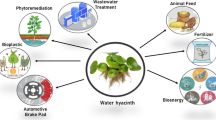Abstract
In the present paper, the possibility of the application of marine macroalga Ulva (Enteromorpha) prolifera, as microelemental feed supplement for livestock, was evaluated. The concept was based on two facts: the natural macroalga contains high concentrations of microelements and there is a possibility to greatly increase this content via biosorption. In order to characterize the biosorption process of metal ions by U. prolifera, preliminary experiments were conducted with Cr(III) ions. The effect of temperature, pH and the biomass concentration on the equilibrium of biosorption was investigated. For further experiments (biosorption of Mn(II), Zn(II), Cu(II), Co(II)), the following experimental conditions were chosen: pH 5, 25°C, the biomass concentration 1.0 g l−1. Equilibrium of the biosorption process could be described by the Langmuir equation. The theoretical maximum biosorption capacity was also determined by potentiometric titration of the biomass. The investigation of the external structure of the macroalga and atomic concentration of elements on the surface of the biomass was analyzed using scanning electron microscopy. The content of microelements in the biomass after biosorption increased 110,555; 44,228; 21,177; 2,281 and 1,458 times for Co(II), Cr(III),Cu(II), Zn(II), Mn(II), respectively. Therefore, biomass of U. prolifera enriched with individual microelements, mixed in the proper proportion could be used as feed supplement in animal feeding to cover the nutrient requirements for microelements.






Similar content being viewed by others
References
Aguilera-Morales M, Casas-Valdez M, Carrillo-Domínguez S, González-Acosta B, Pérez-Gil F (2005) Chemical composition and microbiological assays of marine algae Enteromorpha spp. as a potential food source. J Food Compost Anal 18:79–88. doi:10.1016/j.jfca.2003.12.012
Chojnacka K (2006) The application of multielemental analysis in the elaboration of technology of mineral feed additives based on Lemna minor biomass. Talanta 70:966–972. doi:10.1016/j.talanta.2006.05.063
Chojnacka K (2007) Using biosorption to enrich the biomass of Chlorella vulgaris with microelements to be used as mineral feed supplement. World J Microbiol Biotechnol 23:1139–1147. doi:10.1007/s11274-006-9344-9
Dhargalkar VK, Pereira N (2005) Seaweed: promising plant of the millennium. Sci Cult 71:60–66
Dodson JR, Aronson JM (1978) Cell Wall Composition of Enteromorpha intestinalis. Bot Mar 21:241–246
Han X, Wong YS, Fung N, Tam Y (2006) Surface complexation mechanism and modeling in Cr(III) biosorption by a microalgal isolate, Chlorella miniata. J Coll Inter Sci 303:365–371. doi:10.1016/j.jcis.2006.08.028
Haroon AM, Szaniawska A, Normant M, Janas U (2000) The biochemical composition of Enteromorpha spp. from the Gulf of Gdańsk coast on the southern Baltic Sea. Oceanologia 42:19–28
Hayden HS, Blomster J, Maggs CA, Silva PC, Stanhope MJ, Waaland JR (2003) Linnaeus was right all along: Ulva and Enteromorpha are not distinct genera. Eur J Phycol 38:277–291. doi:10.1080/1364253031000136321
Jamroz D, Podkówka W, Chachułowa J (2004) Żywienie zwierząt i paszoznawstwo, vol 3. PWN, Warsaw
Mamatha BS, Namitha KK, Senthil A, Smitha J, Ravishankar GA (2007) Studies on use of Enteromorpha in snack food. Food Chem 101:1707–1713. doi:10.1016/j.foodchem.2006.04.032
McDowell LR (1996) Feeding minerals to cattle on pasture. Anim Feed Sci Technol 60:247–271. doi:10.1016/0377-8401(96)00983-2
NRC (1981) Nutrient requirements of goats. National Academy Press, Washington DC
NRC (1985) Nutrient requirements of sheep, 6th edn. National Academy Press, Washington DC
Pliński M, Jóźwiak T (2004) The distribution of water vegetation on the Polish coast of the Baltic sea in 1996–2000. Oceanolog Hydrobiol Stud 33:29–40
Raize O, Argaman Y, Yannai S (2004) Mechanisms of biosorption of different heavy metals by brown marine macroalgae. Biotechnol Bioeng 87:451–458. doi:10.1002/bit.20136
Rutkowski A (1996) Wartość pokarmowa zbóż dla kurcząt brojlerów. Roczn AR w Poznaniu. Rozprawy Nauk 267:22–25 (in Polish)
Shimada S, Hiraoka M, Nabata S, Lima M, Masuda M (2003) Molecular phylogenetic analyses of the Japanese Ulva and Enteromorpha (Ulva, Ulvophyceae), with special reference to the free-floating Ulva. Phycol Res 51:99–108. doi:10.1111/j.1440-1835.2003.tb00176.x
Smulikowska S (1993) Standards in swine feeding. Omnitech Press, Warsaw
Smulikowska S (1996) Standards in hen feeding. PAN, Warsaw
Szefer P, Skwarzec B (1988) Concentration of elements in some seaweeds from coastal region of the southern Baltic and in the Żarnowiec Lake. Oceanologia 25:87–98
Volesky B (2004) Sorption and biosorption. BV-Sorbex Inc., St Lambert
Wahbeh MI (1997) Amino acid and fatty acid profiles of four species of macroalgae from Aqaba and their suitability for use in fish diets. Aquaculture 159:101–109. doi:10.1016/S0044-8486(97)00183-X
Yan X (1999) Assessment of calcareous alga Corallina pilulifera as elemental provider. Biom Bioen 16:357–360. doi:10.1016/S0961-9534(98)00084-1
Yongnian N, Shouhui C, Serge K (2002) Spectrophotometric determination of metal ions in electroplating solutions in the presence of EDTA with the aid of multivariate calibration and artificial neural networks. Anal Chim Acta 463:305–316. doi:10.1016/S0003-2670(02)00437-3
Yousif OM, Osman MF, Anwahi AR, Zarouni MA, Cherian T (2004) Growth response and carcass composition of rabbitfish, Siganus canaliculatus (Park) fed diets supplemented with dehydrated seaweed, Enteromorpha sp. Emir J Agric Sci 16:18–26
Yun YS, Park D, Park JM, Volesky B (2001) Biosorption of trivalent chromium on the brown seaweed biomass. Environ Sci Technol 35:4353–4358. doi:10.1021/es010866k
Acknowledgments
This research was financially supported by Ministry of Science and Higher Education (R05 014 01). We would also like to thank Professor Jan Matuła, Dr. Dorota Richter and Dr. Mirosława Pietryka from the Department of Botany and Plant Ecology of the Wrocław University of Environmental and Life Sciences for identification of the alga.
Author information
Authors and Affiliations
Corresponding author
Rights and permissions
About this article
Cite this article
Michalak, I., Chojnacka, K. Edible macroalga Ulva prolifera as microelemental feed supplement for livestock: the fundamental assumptions of the production method. World J Microbiol Biotechnol 25, 997–1005 (2009). https://doi.org/10.1007/s11274-009-9976-7
Received:
Accepted:
Published:
Issue Date:
DOI: https://doi.org/10.1007/s11274-009-9976-7




